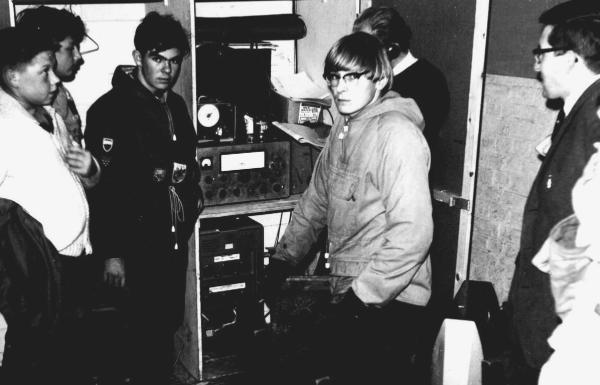
| Oxford University Radio Society 1963 - 1971 |
If you came here from the tinyurl.com/ychgn92x link published in the January 2018 edition of RadCom, you would do better to start at the OURS Home Page by clicking This Link
I came up to Oxford in 1963, with a strong hobby interest in all matters electronic. I was pleased to find that the university had a thriving "Radio Society" and I immediately joined it. The main activity of the society was to hold regular weekly meetings during term time. These were addressed either by members of the society or by visiting speakers talking on a more or less technical theme. Vic Hartop, from J-Beam aerials was a regular visitor. At least once a year, Geoffrey Horn and Phil Tandy from "Horns" in Summertown, came along with the latest gear, to give a Hi-Fi demonstration. This was always a popular meeting, appealing to a wider audience than just us "techies", and it was often made into an open meeting.
My recollection was that the society itself owned very little usable equipment at that time. There was an old World War II, Hammarlund receiver, which could be coaxed into receiving short wave signals, provided they were strong enough. Its most memorable feature was its official spares-kit, which included a hammer, together with instructions as to how this was to be used to destroy some of the more critical tubes (valves to us Britons) if the set were likely to fall into enemy hands.
Ian, G3SEK reminds me that there was also a homebrew HF CW transmitter which was totally unusable, with a lethal power supply (believed to have been mandatory in those days!).
HF operation was further hampered by a total ban on any outside aerials. Fortunately the building had a small "back staircase", hidden away behind the main staircase used by the occupants of the building. It would have been the servants' staircase when the Gate House was built. Ian, G3SEK takes up the story:
"There was 'half a mile' of TV coax up the back staircase to the loft, which would no doubt have been the servants' rooms but were completely empty. The whole top storey was big enough to string a full-size 40m dipole in a straight line through all the open doorways. The reason we could never get out, I think, was the massive walk-around leaded gutter that encircled the whole house at loft level. (Even so, the loft would have still have made a much better clubroom than the cellar, but we never dared ask permission to move because we suspected we weren't supposed to be up there at all.)
"There was also a Pye PMR transmitter (ancient even then) that somebody had donated to OURS. Since HF was obviously hopeless from the Gate House, I decided to give it a try - and that's what got me started on the VHF track. With the above-mentioned lethal PSU instead of the dynamotor, and a 7/6d FT243 crystal, it actually worked and gave out power... eventually, it even gave out power on 70MHz. The receiver was a HB converter to feed the Hammarlund, and the antenna was a temporary dipole, put out on the roof on Sunday mornings, but invisible from below thanks to the gutter."
It was whilst were were at Magdalen Gate House, that we were given two rather newer pieces of equipment, by companies whose representatives had come along as speakers to our meetings and had been unable to resist our "begging bowl". One was a Ship-to-Shore Radio. It was an amplitude modulated transmitter and receiver and had presumably been superceeded by a newer model. It was always affectionately known as "The Fishphone" The second gift was a Frequency Synthesiser. This was not easy to use, by modern standards but it was very stable and it could be used to drive the Fishphone Transmitter to give variable frequency operation. (In its original form this transmitter was crystal controlled on one of 5 frequencies).
At about the same time, we were given a G2DAF Receiver by an "anonymous donor". The donor was in fact a member of the society, Hamish Robertson, a Rhodes Scholar from Canada. Although never a licenced radio amateur himself, Hamish was a keen member of OURS and interested in some of the scientific aspects of radio. He recalls:
"One thing I remember is building a radio telescope with Ian (G3SEK) and some generous help from the Department of Physics. After a struggle including a standoff against some horses who coveted the grass under our corner reflectors and dipoles, we managed to detect the Sun and Cassiopoeia A on 85 MHz."
Hamish bought the G2DAF receiver from an advertisement in the "RSGB Bulletin" as "RadCom" was then called, (with hindsight, it had been somebody's failed construction project) and he donated it anonymously to OURS to help get us going.
It worked, but never quite as well as we felt it was capable of doing. It was always fairly "deaf" particularly on the higher frequency bands. Several of us spent many hours trying to get it working properly. I can remember having it at home over one long vacation and getting quite frustrated with it. There seemed to be no single cause, just a general lack of gain in several stages, coupled with losses in the elderly crystals making up the crystal filter. With our present knowledge and some decent test equipment it could probably have been brought up to specification with no trouble. But we were young and inexperienced and had little more than a multimeter to help us. Still it was an educational experience, and it was certainly vastly better than either the Hammarlund receiver, or the receiver in the Fishphone rig. It served us well for a number of years.
At about that time some of the older housing in the St. Ebbes district was being cleared in preparation for re-development. Some of the cleared areas were surfaced in tarmac, for use as temporary car parking. In the corner of one of these, at the junction of Bridge Street and Norfolk Street, there was a Scout Hut. We obtained permission to hold our meetings there, and construct a lock-up cupboard in one corner to house our radio station.
Unlike the Magdalen Gate House, outside aerials were not actually banned. However the Scouts, not wanting to upset their landlords, the city council, insisted on our obtaining planning permission. Ian G3SEK has reminded me of the forms we had to fill in. The planning authority were oddly insistant to know how our aerial would be connected to the main drainage? In due course we dreamt up a suitable answer and got our permission. So we purchased a light-weight portable mast, from the local Army Surplus store. It was generally reluctant to go up straight and so was known as "The Banana Pole". We used it to support a rather bent dipole and a convenient advertising hoarding served to screen this from potential vandals (and council drainage inspectors!). This actually worked and we got out reasonably well on 80m CW - practically the only band and mode the Fishphone was any good for. (Though Tony, G3VBZ, claims he had the only voice with a sufficient dB rating to get a reasonable modulation level out of the transmitter on AM.)
The resultant links with the Scout movement, provided some opportunities for joint activities. The photograph below was taken on the occasion of a particularly ambitious "wide game" organised by Philip Hetherington and the University Venture Scout Troup, for the benefit of some of the local Scout groups. The scenario was pretty complicated but included a radio link set up between the Scout Hut in St. Ebbes and and a portable station set up in the garden of an obliging don, Angus Hellawell, in Binsey.

The Fishphone Transmitter is standing on the floor at the left hand side of the cupboard, with the G2DAF Receiver on the shelf above it. Standing at the extreme right is Alan Shepherd G3RKK, whilst operating the equipment and almost completely hidden, is Ian White G3SEK. The remaining people are members of the Scouts who had brought whatever "secret message" we were relaying to Binsey. No photograph exists of the Binsey end of the link as far as I know, but the picture below, taken at the landing stage of the Perch Inn at Binsey, shows an intrepid scout about to cross the Thames on the good ship S.S. Sidney Watson.
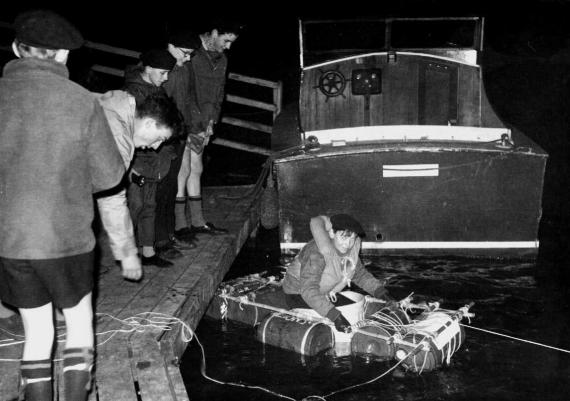
Whilst the scout hut in St. Ebbes was very handy for regular use, the scope for aerials within the small site was limited, and a hill-top was thought to be a better prospect. This made Youlbury an obvious choice. Youlbury is a permanent Scout Camp Site, on the top of Boars Hill about 5km SW of Oxford. It is now in Oxfordshire but in 1966, before the county boundary changes, it was still in Berkshire. Youlbury has its own web site at http://www.youlbury.com/ and lays claim to being the first permanent Scout Camp Site in the world.
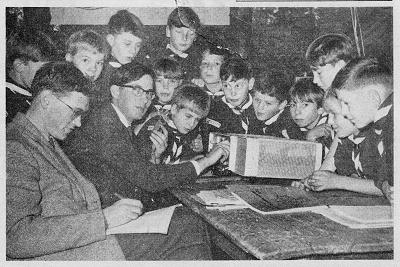 Rather than relying on the Fishphone transmitter, in an era when the rest of the world
was starting to use Single Sideband (SSB), we asked KW Electronics if they would be prepared
to lend us something more modern. They very kindly said "yes" and for the weekend we were
the proud operators of a brand new KW2000 transceiver. We set up our station in the Lawn Hut
and erected our famous Banana Pole in the middle of the lawn. Ian, G3SEK recalls:
"For most of us, that first Youlbury event with the borrowed KW2000 was
our first experience of SSB and of transceive operation. I don't remember
working an awful lot of JOTA stations, but I do remember working Ws in
the middle of the night on 80m SSB, by furiously cranking the VFO knob
between the US and European phone segments."
Rather than relying on the Fishphone transmitter, in an era when the rest of the world
was starting to use Single Sideband (SSB), we asked KW Electronics if they would be prepared
to lend us something more modern. They very kindly said "yes" and for the weekend we were
the proud operators of a brand new KW2000 transceiver. We set up our station in the Lawn Hut
and erected our famous Banana Pole in the middle of the lawn. Ian, G3SEK recalls:
"For most of us, that first Youlbury event with the borrowed KW2000 was
our first experience of SSB and of transceive operation. I don't remember
working an awful lot of JOTA stations, but I do remember working Ws in
the middle of the night on 80m SSB, by furiously cranking the VFO knob
between the US and European phone segments."
The photograph here shows the transceiver being operated by Alan Shepherd G3RKK, whilst I sit beside him keeping the log and a surrounding crowd of youngsters make a more or less successful attempt at looking interested, for what was clearly a carefully posed picture!
Certainly in 1968 we returned to Youlbury. This time, one of our members, brought along his own SSB transmitter (a KW Vespa ??). In my first draft I attributed this to Tony Garratt-Reed, G3VBZ, but he assures me that it was not his. Anyone lay claim to it? Maybe Darrel, G3SYS? We used it in conjunction with my home-made all solid-state receiver. This looked pretty horrible but worked quite well and was easier to transport than the G2DAF receiver. It is still going strong, 34 years later (and still looks horrible!). The picture below shows Tony Garratt-Reed, G3VBZ, operating the station in all its glory. Tony, being the only member of OURS who was also a Scout, is also kitted out in all his glory!
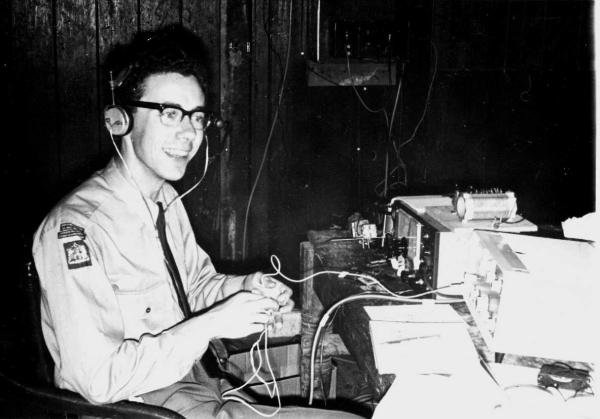
I have quite a number of photographs taken at this event and rather than fill this page up with them, I have put them on a separate page which you can view by clicking here.
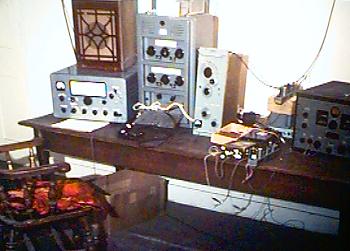 The view here shows one of the two tables, with most of the radio equipment on it. On the left
is the G2DAF receiver, with a rather magnificent old loudspeaker on top. Next to that is the
HF bands Fishphone rig, with the frequency synthesiser standing beside it. The collection
of small chassis and die cast boxes to the right of the synthesiser made up a 2m rig. The
transmitter is the strip chassis standing on its power supply at the back. It used a QQVO3-10
output valve and delivered about 15W. In front of it is its modulator and a receive convertor.
To the extreme right is the Hammarlund receiver which was probably being used as a tunable
IF for the 2m receiver. Both this photograph and the next one were taken early in 1970.
The view here shows one of the two tables, with most of the radio equipment on it. On the left
is the G2DAF receiver, with a rather magnificent old loudspeaker on top. Next to that is the
HF bands Fishphone rig, with the frequency synthesiser standing beside it. The collection
of small chassis and die cast boxes to the right of the synthesiser made up a 2m rig. The
transmitter is the strip chassis standing on its power supply at the back. It used a QQVO3-10
output valve and delivered about 15W. In front of it is its modulator and a receive convertor.
To the extreme right is the Hammarlund receiver which was probably being used as a tunable
IF for the 2m receiver. Both this photograph and the next one were taken early in 1970.
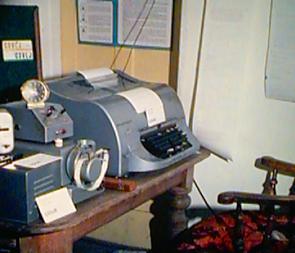 At about that time we had a visit to the Post Office's teleprinter repair workshops, which
at the time were located in the old Oxford Barracks, in Hollow Way. Not only was it an interesting visit, but they promised us to look out for an obsolete teleprinter for us.
Soon after, we were the proud owners of a Creed model 54, which can be seen here together with
its power supply and a paper tape reader. There does not seem to be any sign in this photograph
of a terminal-unit, used to connect the teleprinter to the radio receiver. It would probably
have been on the other table, to the right of the Hammarlund receiver. I distinctly
remember building one. If my memory is correct, transmission of RTTY was achieved by a link
into the frequency synthesiser, which had facilities for frequency shift keying. Certainly we had a number of RTTY contacts from the Keble Road station at around that time.
At about that time we had a visit to the Post Office's teleprinter repair workshops, which
at the time were located in the old Oxford Barracks, in Hollow Way. Not only was it an interesting visit, but they promised us to look out for an obsolete teleprinter for us.
Soon after, we were the proud owners of a Creed model 54, which can be seen here together with
its power supply and a paper tape reader. There does not seem to be any sign in this photograph
of a terminal-unit, used to connect the teleprinter to the radio receiver. It would probably
have been on the other table, to the right of the Hammarlund receiver. I distinctly
remember building one. If my memory is correct, transmission of RTTY was achieved by a link
into the frequency synthesiser, which had facilities for frequency shift keying. Certainly we had a number of RTTY contacts from the Keble Road station at around that time.
Shortly after these pictures were taken, there was a university initiative to provide funds to improve the equipment of the various "Outdoor Activities" clubs. We had already established the principle that amateur radio fell within the university's definition of an outdoor activity. (It was through the good offices of the outdoor activities centre that we had obtained permission to use the room in Keble Road.) So we applied for, and rather to our suprise received, money to buy a modern HF transceiver. This meant that we were at last able to join the rest of the world on the HF bands, in using Single Sideband (SSB) rather than Amplitude Modulation (AM). The transceiver purchased was a Sommerkamp FTdx500. The "Sommerkamp" brand name lasted only about a year, before being renamed "Yaesu", at about the time when the first FT101 was introduced. The log reveals that the first contact with the new transceiver was made on 23rd January 1971.
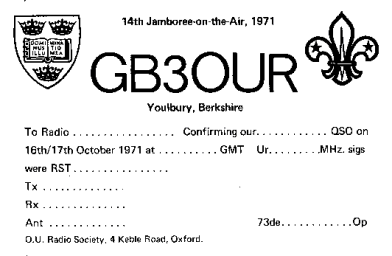 I don't have any recollection of our operating a fully-blown Jamboree Station in 1969 or 1970
and I have no photographs or diary entries relating to one. However Simon G3XXH has an entry in
his log for 18th October 1969 for a QSO with G3OUR/A operating from Youlbury. The operator was
"Alan" and he was cold! That sounds like me on both counts. The contact was on 160m and I suspect
we may just have taken up a single rig and a long wire antenna for one day.
I don't have any recollection of our operating a fully-blown Jamboree Station in 1969 or 1970
and I have no photographs or diary entries relating to one. However Simon G3XXH has an entry in
his log for 18th October 1969 for a QSO with G3OUR/A operating from Youlbury. The operator was
"Alan" and he was cold! That sounds like me on both counts. The contact was on 160m and I suspect
we may just have taken up a single rig and a long wire antenna for one day.
My final involvement in JOTA with OURS was in 1971. By this stage I had just left Oxford and was living in Luton and so was not involved with organising the station, which was again set up at Youlbury. However I came over for the actual weekend, to join in the fun. I have a note in my log of a contact made from Keble Road, where I operated as G3UMF/A to G3OUR/A at Youlbury. This was at about 4pm on the 16th of October and I have a note that Jim G8DNE was also with me at Keble Road. Presumably we both then drove on up to Youlbury. From the special QSL cards printed for the event, it would seem that a special event callsign GB3OUR was in use, but it seems to have been as G3OUR/A that I worked them. I wonder why?
A web search for references to G3OUR when I was first setting up these pages, revealed this quote from Dave, G4BUO: "I cut my teeth in contesting in the seventies from the G3OUR university station. We mounted a tribander on the flag pole above the lift housing of the engineering building, and it was impossible to rotate the beam. Therefore the ARRL was the obvious contest to enter. The first year we fed the beam with TV coax and ran an FT400 barefoot, and the pileups (on all four weekends) were huge."
Dave has subsequently sent along some detailed reminiscences and photographs from the late 1970's and these appear on the 1975-1979 page of this site.
The same web search also provided this quote from Richard, G3CWI: "The funniest thing that happened during a contest was... I fell asleep working W6 stations on 80m CW during the ARRL CW (operating as G3OUR, many years ago!).
Richard has confirmed that although never a member of OURS he came along with James G4EZN to operate in several ARRL contests in the late 70's.
Dave G4BUO and Steve G4GFX have both subsequently provided more details and these are included on the 1975-1979 page of this site.
An advance write-up on one of the above expeditions in the August 1979 issue of RadCom, makes reference to the club's "New Premises at 62 Banbury Road, Oxford." and Dave and Steve have also provided details and photos of this QTH.
In 2004, this tradition was revived, thanks largely to the efforts of Stavros, M0BBB at Cambridge, and Dave, G4BUO formerly at Oxford. You can read more about it here.
| Copyright © Alan Simpson 2001-2020 | Back to the OURS Index | Last Updated 2020-07-05 |